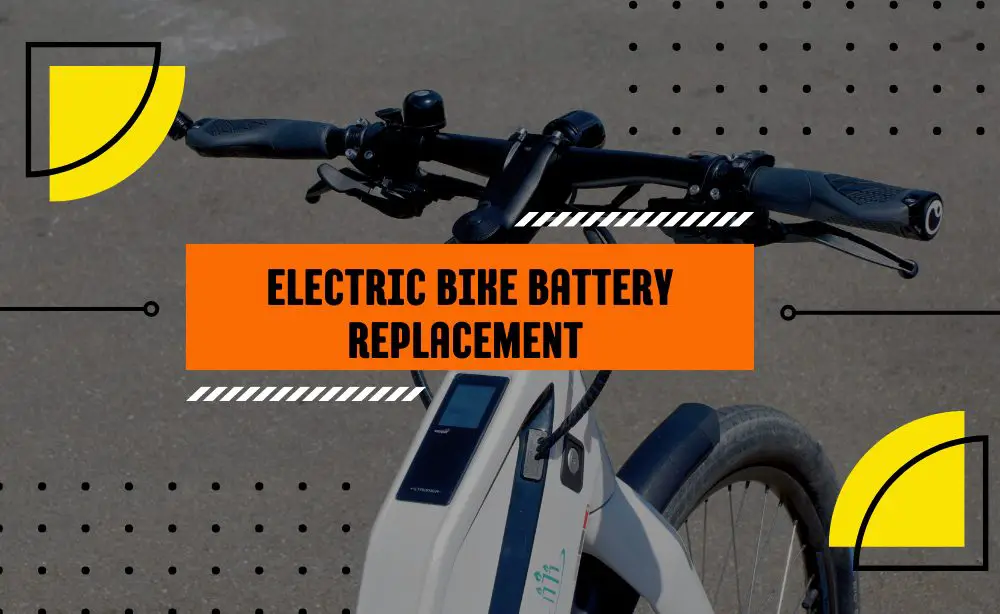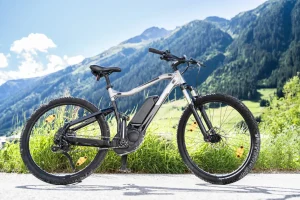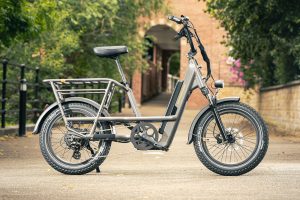Ebike Battery Replacement, Electric bikes have become a common sight on streets worldwide. Their eco-friendly nature and cost-effectiveness make them an attractive choice for commuting and recreational purposes. Central to the functionality of an electric bike is its battery, a crucial component that demands attention when signs of wear and tear become evident.

Signs Your Ebike Battery Replacement Needs
Diminished Range on a Single Charge
One of the first indicators that your ebike battery is on the decline is a noticeable reduction in the distance it can cover on a single charge. If your once-trusty steed is now struggling to reach distances it effortlessly covered before, it might be time for a battery replacement.
Slow Charging or Failure to Hold a Charge
If the charging process takes significantly longer than it used to, or your ebike fails to hold a charge for an adequate period, your battery may be losing its efficiency. This is a common signal that it’s approaching the end of its lifecycle.
Physical Damage to the Battery Pack
Visual inspection is crucial in assessing the health of your ebike battery. If you notice any physical damage to the battery pack, such as leaks, bulges, or cracks, it’s imperative to address the issue promptly. Physical damage not only affects performance but can also pose safety risks.

Understanding Ebike Batteries
Ebike batteries are the lifeblood of these eco-friendly machines, providing the juice that propels you forward with pedal-assisted power. But unlike their gasoline-powered counterparts, ebikes require a different kind of understanding when it comes to their batteries.
Anatomy of an Ebike Battery:
- Battery Cells: The core of the battery, typically Lithium-ion cells, are linked together in series and parallel to achieve the desired voltage and capacity.
- Battery Management System (BMS): This electronic brain protects the battery from overcharging, overheating, and deep discharge, ensuring its safety and longevity.
- Case and Housing: The sturdy outer shell safeguards the internal components from the elements and physical damage.
Key Battery Specs:
- Voltage (V): Typically 36V or 48V, determines the power and speed output of your ebike. Higher voltage generally means more power, but also faster battery drain.
- Capacity (Ah): Measured in Amp-hours, dictates the range you can achieve on a single charge. Higher capacity translates to longer rides, but also adds weight and cost.
- Watt-hours (Wh): The product of voltage and capacity, represents the total energy stored in the battery. A higher Wh rating indicates longer potential range.
Choosing the Right Battery:
Matching the right battery to your ebike is crucial. Consider these factors:
- Compatibility: Ensure the battery voltage and physical dimensions match your ebike’s specifications.
- Capacity: Choose a capacity that balances your desired range with weight and budget.
- Brand: Original equipment manufacturer (OEM) batteries offer seamless integration, but compatible aftermarket options can be more affordable.
Caring for Your Battery:
- Store at moderate temperatures: Avoid extreme heat or cold, which can damage the battery.
- Charge properly: Use the correct charger and avoid deep discharge or continuous overcharging.
- Maintain regularly: Clean battery contacts and check for any signs of damage.
The Future of Ebike Batteries:
Constant advancements are pushing the boundaries of ebike battery technology. Expect to see:
- Higher capacities: More range on a single charge.
- Faster charging times: Shorter waiting periods to get back on the road.
- Lighter and more efficient batteries: Improved performance without added weight.
Understanding ebike batteries empowers you to make informed choices, maximize your riding experience, and ensure your electric steed keeps on running smoothly for years to come.
Remember, a happy battery means a happy ebike rider! So, take good care of your battery, choose wisely when replacing it, and enjoy the liberating power of electric cycling.
Additional Resources:
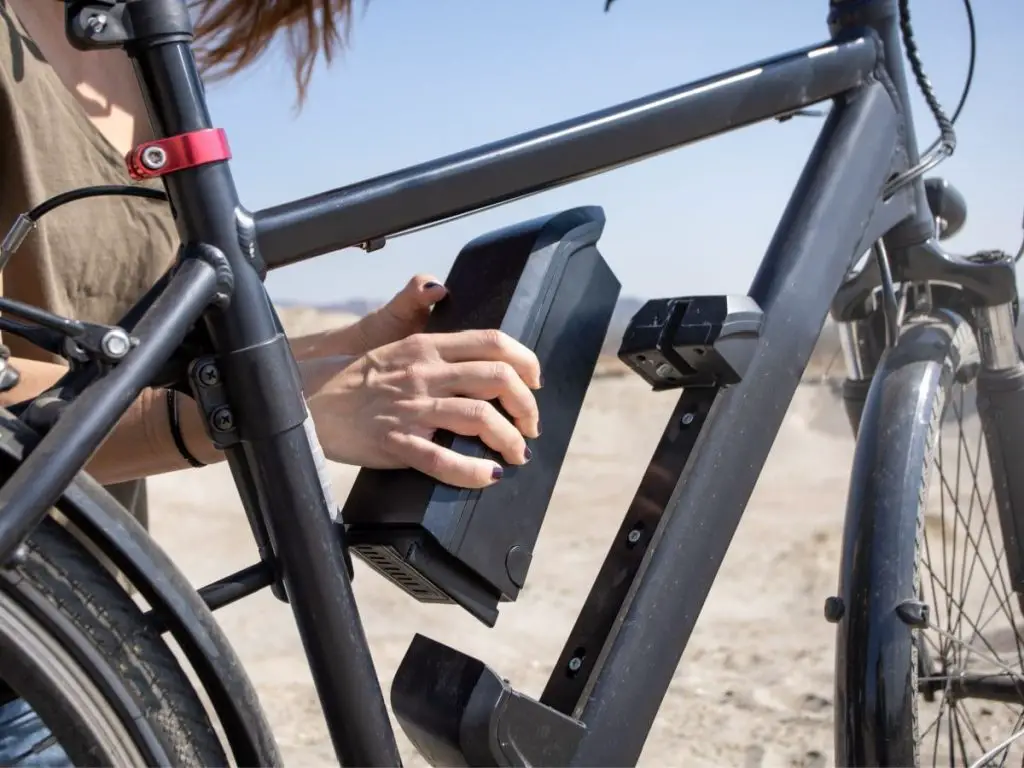
The Ebike Battery Replacement Process
Step-by-Step Guide on Replacing an Ebike Battery
Replacing an ebike battery may seem daunting, but with the right guidance, it can be a manageable DIY task. Begin by ensuring your bike is powered off and safely removing the old battery. Carefully follow the manufacturer’s instructions to connect the new battery, securing it in place.
Common Tools Needed for the Replacement
Before embarking on the replacement journey, gather essential tools, including screwdrivers, wrenches, and possibly a multimeter for testing. Having the right tools ensures a smoother process and reduces the risk of damage to the bike or the new battery.
Choosing the Right Replacement Battery
Compatibility Considerations
Not all batteries are created equal. It’s crucial to choose a replacement battery that is compatible with your specific ebike model. Check the voltage, capacity, and physical dimensions to ensure a seamless fit.
Exploring the Options Available in the Market
The market offers a variety of replacement batteries, ranging from OEM options to aftermarket alternatives. Consider factors such as brand reputation, customer reviews, and warranty coverage when making your decision.
DIY vs Professional Replacement
Pros and Cons of Replacing the Battery Yourself
DIY replacement is appealing for those with technical know-how, offering cost savings and a sense of accomplishment. However, it comes with risks, including potential damage to the bike or voiding warranties.
Benefits of Seeking Professional Help
Opting for professional battery replacement ensures expertise and minimizes the risk of errors. Professionals can also identify and address other potential issues with the bike, ensuring a comprehensive service.
Extending the Lifespan of Your New Battery
Proper Charging Practices
Maximize the lifespan of your new battery by adopting proper charging habits. Avoid overcharging, and when storing the bike for an extended period, maintain the battery at a moderate charge level.
Storage Tips for Unused Batteries
If your ebike will be idle for an extended period, store the battery in a cool, dry place with a partial charge. This helps prevent degradation and ensures optimal performance when you’re ready to ride again.
Environmental Impact and Recycling
Discarding Old Batteries Responsibly
Given the environmental impact of batteries, it’s essential to dispose of old ones responsibly. Many localities have specific regulations for battery disposal, so be sure to adhere to them to protect the environment.
The Environmental Benefits of Recycling
Recycling old batteries contributes to a more sustainable future. Battery recycling helps recover valuable materials and prevents hazardous substances from leaching into the environment.
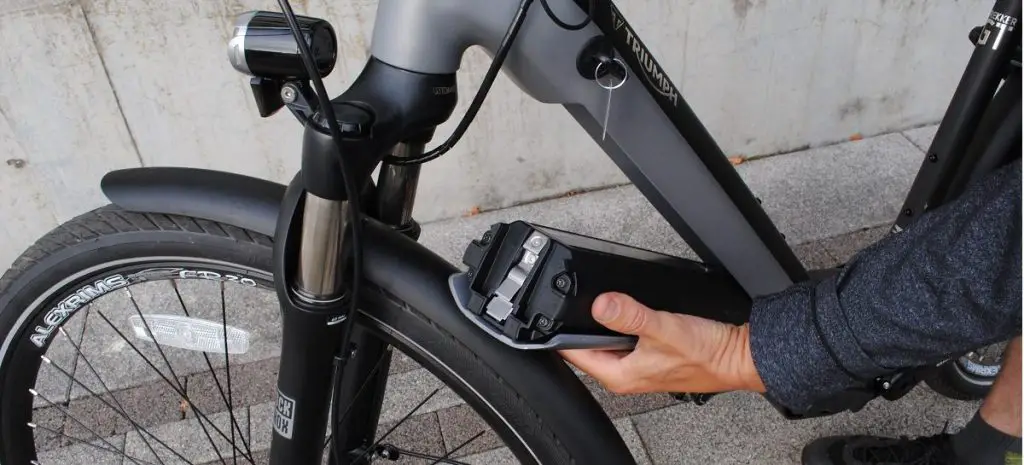
Customer Reviews and Experiences
Navigating the world of ebike batteries can be overwhelming, especially with the vast array of options and brands available. Customer reviews and experiences offer valuable insights, helping you make informed decisions about your next battery purchase. Here’s a breakdown of key themes often found in ebike battery reviews:
Positive Feedback:
- Increased Range: Many riders praise batteries that have extended their ebike’s range, allowing them to explore further and conquer longer distances.
- Improved Performance: Powerful batteries often garner positive reviews for their ability to tackle challenging terrain, climb hills with ease, and deliver a smoother, more enjoyable riding experience.
- Fast Charging: Rapid charging capabilities are a frequent bonus point, allowing riders to quickly get back on the road without lengthy wait times.
- Durability and Reliability: Customers appreciate batteries that withstand long-term use without significant performance degradation or unexpected issues.
- Brand Reputation: Well-established brands with a track record of quality and customer support often receive positive feedback for their batteries.
Common Concerns:
- Range vs. Price: Many reviewers highlight the trade-off between battery capacity and cost, searching for the sweet spot of optimal range within their budget.
- Weight and Size: Bulky or heavy batteries can reduce the agility and handling of an ebike, prompting negative feedback from some riders.
- Compatibility Issues: Incompatibility with specific ebike models or charging systems can be a source of frustration for customers.
- Limited Lifespan: While batteries are expected to degrade over time, reviews often cite concerns about batteries losing capacity prematurely or failing unexpectedly.
- Customer Service: Negative experiences with customer service, warranty claims, or replacement processes can tarnish the overall customer perception of a battery brand.
Tips for Utilizing Customer Reviews:
- Read a variety of reviews: Don’t just focus on the most positive or negative ones. Look for consistent trends and common themes across multiple reviews.
- Consider the reviewer’s background: Pay attention to factors like the reviewer’s ebike model, riding style, and frequency of use to assess the relevance of their experience to your own.
- Look for verified reviews: Trustworthy platforms like Amazon Verified Purchase or Google Reviews offer greater assurance of genuine experiences.
- Combine reviews with other resources: Don’t solely rely on reviews. Research the battery’s specifications, compare prices, and consult trusted cycling blogs or forums for additional insights.
By thoughtfully analyzing customer reviews and experiences, you can gain valuable knowledge about ebike batteries, make informed purchase decisions, and find the perfect power source to fuel your electric adventures. Remember, the ideal battery for you will depend on your individual needs and riding style, so take your time, do your research, and choose wisely!
I hope this information helps!
Maintenance Tips for Ebike Batteries
The mighty heart of your ebike, the battery, deserves some TLC to keep it pumping power and extending your rides. Here are some essential maintenance tips to ensure your battery stays happy and healthy:
Temperature Matters:
- Cool and Calm: Extreme heat and cold are battery enemies. Avoid storing your ebike in scorching garages or freezing sheds. Aim for room temperature, ideally between 15°C and 25°C.
- Post-Ride Chill: Let your battery cool down for at least 30 minutes after a ride before charging. This prevents overheating and stress on the cells.
Charging Wisdom:
- Top it Up, Don’t Fill it Up: Regularly charge your battery, but avoid aiming for 100% every time. Keeping it between 20% and 80% is ideal for long-term battery health.
- Unplug with Love: Don’t leave your ebike plugged in for extended periods, especially after reaching full charge. This can strain the battery and shorten its lifespan.
- Matchmaker, Matchmaker: Use the charger that came with your ebike or one specifically designed for its battery model. Mismatched chargers can be risky.
Cleanliness is Key:
- Wipe it Down: Gently clean the battery contacts with a soft, dry cloth to remove any dirt or corrosion that could disrupt charging.
- Storage Savvy: When storing your ebike for longer periods, charge the battery to around 50% and keep it in a cool, dry place.
Listen to Your Battery:
- Unusual Behavior: Be mindful of any changes in your battery’s performance, like sudden drops in range, slow charging, or strange noises. These could indicate potential issues needing attention.
- Consult the Doctor: If you’re unsure about anything or have concerns about your battery’s health, don’t hesitate to consult your ebike dealer or a qualified mechanic.
Bonus Tips:
- Avoid Deep Discharges: Try not to completely drain your battery before recharging. This can stress the cells and reduce their lifespan.
- Gentle Riding: Aggressive acceleration and constant uphill climbs put extra strain on your battery. Maintain a moderate pace for optimal battery life.
- Update Your Firmware: Some battery manufacturers offer firmware updates that can improve performance and efficiency. Check with your ebike dealer for updates.
By following these simple maintenance tips, you can ensure your ebike battery stays in top shape, powering your adventures for years to come. Remember, a happy battery means a happy rider! So, give your electric heart the care it deserves and keep on rolling!
Innovations in Ebike Battery Technology
Emerging Trends and Advancements in Battery Technology
Stay informed about the latest innovations in ebike battery technology. Advancements may bring improved performance, longer lifespan, and faster charging times to enhance your overall riding experience.
What the Future Holds for Ebike Batteries
As technology continues to evolve, the future of ebike batteries looks promising. Expect to see developments in energy density, lightweight materials, and smart technologies integrated into battery systems.
Cost Considerations
Capacity Matters:
- Range for your Range: The bigger the battery’s capacity (measured in Watt-hours, Wh), the further you can travel on a single charge. Naturally, higher capacity translates to a higher price. Think about your typical riding distances and choose a capacity that balances range with budget.
Voltage Variations:
- 36V vs. 48V: Most ebikes use either 36V or 48V batteries. Generally, 48V batteries offer more power and speed, but also cost more than their 36V counterparts. Consider your desired performance level and riding terrain when making this choice.
Brand Matters:
- OEM vs. Aftermarket: Original equipment manufacturer (OEM) batteries made by the ebike brand often come at a premium due to their guaranteed compatibility and seamless integration. However, compatible aftermarket batteries from reputable brands can offer significant cost savings while maintaining good quality.
Technology Tidbits:
- Cutting-edge vs. Reliable: Newer battery technologies with higher capacities and faster charging times might carry a steeper price tag compared to established, proven technologies. Weigh the cost-benefit balance based on your needs and budget.
Additional Expenses:
- Charger Woes: Some batteries might require special chargers that add to the overall cost. Check if your chosen battery comes with a compatible charger or factor in the additional purchase.
- Warranty Protection: Extended warranties offer peace of mind but come at an extra cost. Consider your risk tolerance and budget when deciding whether to invest in extended warranty coverage.
Saving Smarts:
- Shop Around: Compare prices from different online and offline retailers to find the best deals.
- Seasonal Sales: Keep an eye out for seasonal sales and promotions that can offer significant discounts on ebike batteries.
- DIY Maintenance: Learning basic battery maintenance, like cleaning contacts and storing properly, can help extend its lifespan and potentially avoid costly replacements.
Remember: The ideal ebike battery cost is a balance between your budget, desired range and performance, and long-term value. Choose wisely, maintain your battery with care, and enjoy the electric freedom your trusty steed offers!
By understanding these cost considerations, you can navigate the ebike battery market with confidence and find the perfect power source that fuels your adventures without breaking the bank. Happy riding!
Comparing Brands and Models
Popular Ebike Battery Brands in the Market
Explore the reputation of various ebike battery brands. User reviews, industry recognition, and brand history can provide valuable insights into the reliability and performance of different models.
Features to Look for in a Replacement Battery
Consider essential features such as capacity, voltage, and durability when comparing replacement options. Look for batteries that align with your specific riding needs and preferences.
Warranty and After-Sales Support
Importance of a Good Warranty
A robust warranty reflects the manufacturer’s confidence in their product. Prioritize replacement batteries that come with a substantial warranty to protect your investment.
What to Expect from After-Sales Service
Research the after-sales service provided by the manufacturer. Quick and responsive support can make a significant difference in addressing any issues that may arise post-purchase.
Youtube Tutorial
Conclusion
In conclusion, replacing an ebike battery is a crucial aspect of maintaining your electric bike’s performance. By understanding the signs of battery deterioration, choosing the right replacement, and adopting proper maintenance practices, you can ensure a reliable and enjoyable riding experience. Stay informed about advancements in battery technology, and always prioritize responsible disposal methods for old batteries.
FAQs
Q: How often should I replace my ebike battery?
A: The lifespan of an ebike battery varies, but on average, it’s recommended to consider replacement every 2-5 years, depending on usage and charging habits.
Q: Can I use any replacement battery for my ebike?
A: It’s crucial to choose a replacement battery that is compatible with your specific ebike model. Check the manufacturer’s specifications to ensure a proper fit.
Q: Is DIY battery replacement safe for beginners?
A: While some individuals successfully replace their ebike batteries, it’s advisable for beginners to seek professional assistance to avoid potential damage and ensure safety.
Q: Are there any eco-friendly options for ebike batteries?
A: Yes, some manufacturers prioritize eco-friendly materials and recycling programs in their battery production. Research brands committed to sustainability for greener choices.
Q: What should I do with my old ebike battery?
A: Dispose of old ebike batteries responsibly by following local regulations. Many recycling centers accept batteries to prevent environmental harm.
